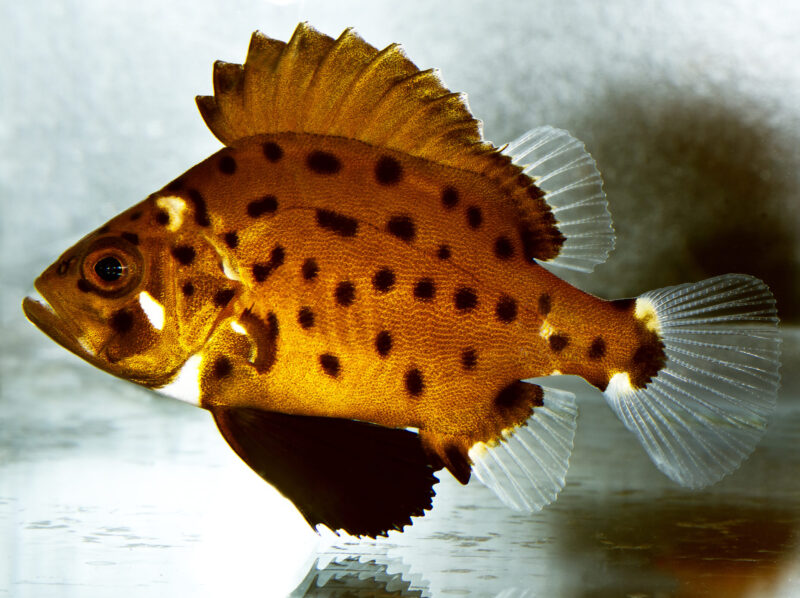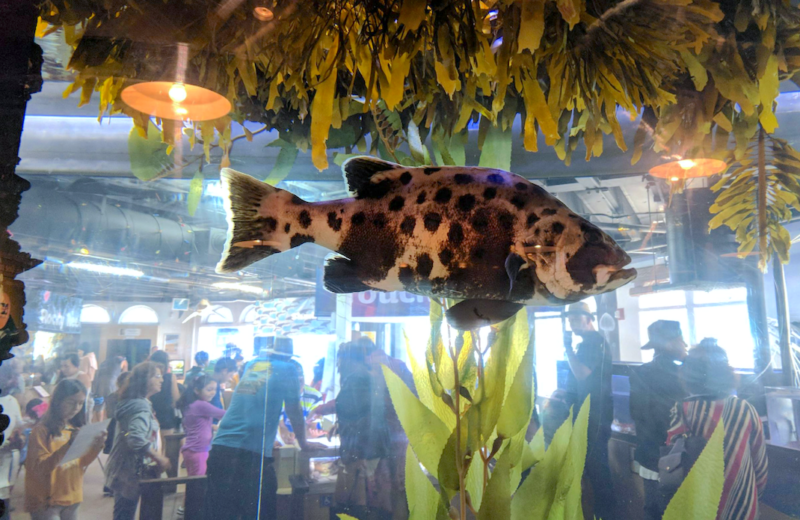Mike Couffer has been working alongside Heal the Bay Aquarium to research giant sea bass, the largest bony fish local to LA waters. In this blog, Mike recounts his research on these fish and their uniquely identifying spots, as well as our Aquarium’s journey raising and releasing a giant sea bass.
Early in the morning on May 21, 2021, aquarists from Heal the Bay Aquarium arrived in Redondo Beach with a truck and a seawater tank holding precious cargo: a 40-pound giant sea bass. This giant sea bass, which had been raised for research and education over the last 5 years, had outgrown its tank and was now ready to be released into the ocean. The fish was fitted with an acoustic transmitter that would send signals for about 10 years as it passed receivers scattered along the coast. It’s a straight shot to the open sea along the harbor’s jetty, and the fish could leave the harbor or stay awhile and feast on the lobsters near jetty rocks. Either way, the giant sea bass would be free and in another 5 years or so should be old enough to spawn and help boost California’s recovering population of this historically overfished species.
Giant sea bass are the largest bony fish inhabiting California and Mexico’s near-shore waters, reaching 9 feet long and over 800 pounds during at least a 76 year lifespan. They range from Northern California to Oaxaca, Mexico, including parts of the Gulf of California. After overfishing decimated their numbers during the early 1900s, they were listed as a critically-endangered species internationally and restricted from intentional catch in California.
But while protecting adult fish from fishing pressure is important, protecting their young is also needed. Until 2013, little was known about giant sea bass babies but masters degree candidate Stephanie Benseman found that in California, most of the babies grow up in soft bottomed nursery sites along beaches inshore from the few heads of submarine canyons that start close to shore. The best location known for baby giants are the shallows off Redondo Beach in Los Angeles from Redondo Pier outside of King Harbor to a jetty 800 yards down the coast.
During my first baby giant sea bass dives with Stephanie, I was hooked into studying them by an incongruity; how could we not know even the most basic information about the babies of our largest nearshore fish? I would spend the next seven (and counting) years studying them. As they age, the fish change color from jet black to brown, to orange, a mottled calico, and then a dark brown with black spots. But it’s the orange with black polka dots phase of the babies that draws your attention; this spot pattern develops in the early brown stage and becomes striking when their background color turns orange.

I noticed that each fish’s spot pattern was different from every other. Could we use underwater photos of their spot patterns like fingerprints to identify individual fish in the ocean? If so, maybe we could learn about the behavior and movements of individual fish in the ocean. I couldn’t answer this question in the ocean because if I photographed a fish one day and the fish’s spots changed slightly, I couldn’t be absolutely sure that the fish I photographed next time was the same fish or a different one.
That’s where teaming up with Heal the Bay Aquarium came in. I needed experienced aquarists to raise a baby sea bass while I photographed its spot patterns as it grew. I would use my collecting permit and expertise to catch a baby giant and bring it to them. They would care for and display the little bassling for visitors to enjoy and learn about. Once a month for a year, I’d visit and take photos of the spot patterns on both sides of the fish and they would weigh and measure it. If the spot patterns of baby giant stayed similar enough to be recognized in photos as the fish aged, photos of their sides could be used like fingerprints to identify individual giant sea bass, maybe for the rest of their lives. After a year, I would write my scientific paper on any changes in the spot patterns of the baby giant sea bass that I gave to Heal the Bay.
In November 2015, I dived the Newport Pier giant sea bass nursery site in Orange County with a little hand net and caught a 1 3/8 inch brown-phase baby giant with a special permit from the California Department of Fish and Wildlife. I photographed the spot patterns of both sides in a tank and brought the baby giant to Heal the Bay Aquarium. No baby giant of this age had ever been successfully raised before, so there was little knowledge about how to care for them, but Aquarium staff were up for the challenge and succeeded!
At the end of each month, I photographed the baby bass in its tank and watched the Aquarium team measured and weighed the fish. A year passed and by November 2016 the baby bass had grown from 1 3/8 inches long and 5/10 tenths of an ounce to 7 inches long and five ounces. In my 2017 scientific paper, I showed that you could compare baby pictures of five baby giant sea bass by eye and recognize individuals for the first year. This meant that it was possible to study the babies in their shallow nursery sites using underwater photography and perhaps learn something about their behavior and movements.

By the end of 2016, the sea bass had become an important member of Heal the Bay Aquarium’s fish community where over 70,000 visitors a year learned about the fish or just enjoyed watching it. Managers and aquarists joined the aquarium, cared for the fish, and left to chart other courses in the world. The fish continued to educate and entertain and there was no motivation to release the fish yet; it’s believed that they don’t breed until they are at least 10 years old, so keeping a fish for five years and releasing it wouldn’t impact the population. I kept photographing the fish and aquarists weighed and measured it every six months. After the fish was transferred to the aquarium’s largest tank, I hoped that we could photograph and measure the fish until five years from its arrival date at the aquarium before it got too big for its tank.
November 2020 arrived and I photographed the fish one last time. Aquarists weighed and measured the fish five years after I had brought it to the aquarium. With these photos and measurements and the fish growing larger in the aquarium’s biggest tank, it was nearing time to release it into the sea. The Department of Fish and Wildlife gave permission for the release and I contacted Dr. Chris Lowe of the California State University at Long Beach who had years of experience tracking adult giant sea bass and white sharks with underwater transmitters. Dr. Lowe said that he could fit the now 40-pound fish with the same transmitter worn by white sharks that could “ping” for 10 years. So long as the underwater receivers are maintained, if the fish passes within a receiver’s range it should be recorded as it moves up and down the coast and perhaps to and from the Channel Islands.
On May 21, 2021 at the King Harbor Yacht Club, a small group of scientists and fish caretakers watched the giant sea bass release. Aquarists carefully lowered the fish into the water, while I photographed the occasion. It was a bittersweet moment as the fish swam out across the sandy bottom, but we were all excited by the successful release after five years of raising the baby giant sea bass. With the fish’s unique transmitter active and the underwater receivers ready and waiting, we hope to get occasional electronic travel updates as the giant sea bass swims up and down the coast.
View this post on Instagram
In June of 2022, Michael’s findings were published in Bulletin of Southern California Academy of Sciences. Take a deep dive into this scientific paper, Spot Pattern Stability During Five Years of Growth of a Captive Giant Sea Bass, Stereolepis gigas, to uncover more about the sea bass spots and check out the conclusion to this giant fish tale.
About the Author
Michael Couffer is sole proprietor of Grey Owl Biological Consulting. Mike contracts to conduct focused presence or absence surveys for rare, Threatened, or Endangered wildlife. For the past seven years, Mike has focused on surveys, research, and underwater photography of Giant Sea Bass out of pure fascination with the species and the hope that he can help this historically-overfished species to recover. His latest scientific journal paper was published in the 2020 Department of Fish and Wildlife’s journal California Fish and Wildlife. It focuses on Giant Sea Bass nursery sites and how cities with nursery sites along their shores can build and maintain shoreline infrastructure without impacting baby Giant Sea Bass.



